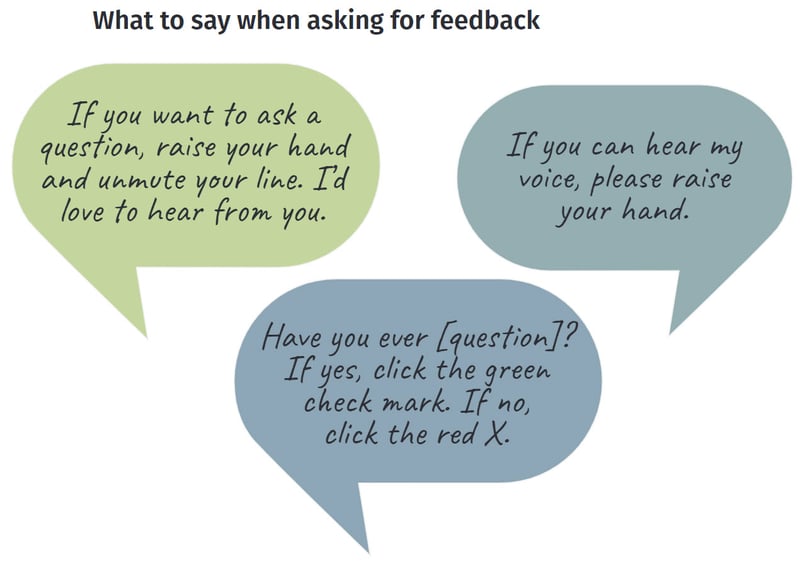With online sales presentations being more necessary than ever, it’s critical to know how to make the most of your time with prospects and customers. The days of building trust and credibility through face-to-face meetings, 5-star dinners, and trips to the golf course are over. So how can you develop meaningful buyer relationships in just a 15-minute Zoom call – and overcome the technical issues, at-home distractions, and lack of genuine connection that come with it?
All it takes is some preparation and a few simple strategies, and you too can have an audience fully immersed in the experience. Try these nine tips and you’ll be sure to up-level your confidence – and outcomes – in online sales meetings.
1. Set Yourself Up for Success
Benjamin Franklin said, “By failing to prepare, you are preparing to fail.” These are the golden words to follow when preparing your online sales presentations.
When conducting a high-stakes demo – or if you simply want to minimize the risk of technical issues – use two separate computers to conduct your virtual sales pitch. On your main computer, login to the virtual room as the host using a name such as “Your name – Presenter” so that your audience can clearly distinguish who you are in the sea of participants. On your back-up device, login as a participant using a name such as “Your name – Backup”. After muting your “participant” computer, this method allows you to be a part of their experience, and you don’t have to guess or ask what they are seeing.
Another pro tip? Use a quality hands-free headset. Your computer’s audio system can be low-quality or pick up background noises in your home. If you’re presenting to a large group, consider setting your participants’ audio to mute to avoid feedback or distracting background noise.
2. Know When to Upload Content vs. Share Your Screen
If your virtual meeting platform allows you to upload content, you have more options to give your participants the best viewing experience. You may prefer uploads if you are a little more tech-savvy.
Uploading content is best if you…
- Often get “pinged” with IMs, meeting reminders, email notifications, etc. and want to keep these private from (or not distract) your audience
- Want to easily skip ahead or go back in your presentation using thumbnails
- Need to mark up your slides by drawing or pointing to something onscreen
Screen sharing is fine when you don’t have the option to upload content or need to flip between sharing multiple browser windows that cannot be uploaded.
Share your screen if you…
- Need to demo tools or products
- Want to edit content in real-time
- Don’t have an alternative (ie: your virtual meeting platform doesn’t support uploading content)
3. Use Storytelling Structure
Beyond the technical aspects of presenting virtually, you’ll want to give your virtual sales pitch the best start by grounding it in a rock-solid foundation. What’s the best way to engage your online audience and get them to lean in and take action? Through story. Craft yours by understanding the basics of what makes a good story. Every great narrative has four primary elements, also known as “signposts.” These signposts tell an audience why they should care and keep listening.
- Setting: Provides context to your story by using data, trends, and any insights into places or situations where (usually) you’ve found shortcomings
- Characters: Establishes an emotional connection – this could be your customers themselves or other key stakeholders like partners, suppliers, or employees
- Conflict: Creates tension and gives your audience a reason to lean in. It’s the question or difficulty that needs to be resolved
- Resolution: Your path to the desired outcome – for most salespeople, it’s the features and benefits of your product or solution
It’s important to note that the first three signposts – Setting, Characters, and Conflict – can come in any order, but Resolution must come last. Can you guess where most sales professionals start their presentations?

4. Make Sure Your BIG Idea Is Clear
Your virtual sales pitch has to be spot-on to stand out from the noise of the crowd. It’s critical to dial into what your customer wants and present precisely that to your audience in your online sales presentations. Do this by identifying your BIG Idea – the one key message you want your audience to remember – and infuse it throughout your presentation.
When telling your story, every fact, figure, and insight within your narrative should tie back to this BIG Idea. The goal is to clarify the idea in such a way that resonates with your customers emotionally, making them feel a strong connection to your story. Your potential customers are suffering from information overload already and feeling overwhelmed, so keep your “BIG Idea” clear. Try not to muddy the waters with additional offers or other information.
5. Use Interactive Placeholders
Want to ensure you create a two-way dialogue with your virtual audience? Plan ahead! Use interactive placeholder slides every 3- to 5-minutes to prescribe interaction into your online meeting to keep your audience engaged.
For instance, add an interactive placeholder slide after you have introduced the main pain points by asking, “Can any of you relate to this?” This gives your customers a chance to A) stop and think about how they see themselves in your story and B) describe their issues – a prime opportunity for you to get real-time feedback. Adding these interactive placeholders at the beginning, end, and other critical junctures not only gives you, the presenter, a moment to pause and catch your breath, but it keeps your audience engaged and supplying critical feedback to guide where you go in your presentation.

6. Fill the Awkward Silence
Suppose you have asked a question to your audience that you would like feedback on, but you’re left with the deafening sound of silence. That enormous awkward space needs filling while your audience tries to figure out their response. Maybe they’re answering a poll question and are choosing the best response. Some may need a minute to figure out how to turn their microphones back on to answer a request for verbal feedback.
You can fill that space by coming prepared with simple language prompts and providing direction as needed. When you help your audience verbally, you fill that awkward dead air with something constructive.

7. Practice, Practice, Practice
Delivering an effective virtual sales meeting takes practice. Are you comfortable multitasking in your virtual environment? Have you practiced using the annotation tools (that allow you to write text, highlight, or point onscreen) while speaking? Be sure to practice ahead of time, not during your live event!
Run through your virtual sales pitch several times beforehand. Try not to precisely memorize a script, but get yourself comfortable with the ideas you want to express and how you want to convey them from your notes. This can also include practicing using the interactive tools you want to use in your online sales presentation. Don’t overly worry about mistakes. Get comfortable with what you want to say and any tools you use.
8. Have a Strong Virtual Presence
With all that practicing, you should also consider how your “virtual body language” comes across. That’s right — the way you carry yourself in your own physical space actually translates to how your audience perceives you, which can mean a huge different between a captivated audience… and a bored one. The more vocally and physically animated you are, the more engaged your audience will be. One best practice is to record yourself beforehand to see how you come off in virtual space.
Before your virtual sales pitch starts, stretch your face a bit and yawn loudly. Get those face and mouth muscles limbered up! Then, when presenting, always have a great posture. Stand and sit straight and gesture like you ordinarily would when speaking in person.
9. Have a Backup Plan for Disasters
Come what may, disasters will happen. Your perfectly planned online sales presentation is no exception if you don’t have a Plan B. The best way to avoid a disaster is to… well… plan for one. If your demo acts up and won’t function, have backup screenshots ready to use instead. Is everyone dozing off and not responding to poll questions? Verify it’s working and remind your audience of the steps to register their response. Crickets in the chatbox? Use pre-prepared questions to get their thought juices churning or type something in the chat yourself.
For high-stakes sales meetings with lots of participants on the call, consider enlisting a “co-pilot” or producer – this could be a colleague, or anyone that’s tech-savvy enough to assist you during the meeting. This simple trick takes the burden of you as the presenter to manage technical issues or background questions that don’t pertain to the content you’re there to deliver.
Plan for Success, and Success Will Follow
So, there you have it— a rock-solid plan to ensure the success of your virtual sales pitch. Going forward, you can feel confident and more able to handle any problems that may pop up during your online sales presentation. If you want to learn more about how to design and deliver compelling sales pitches that get your audience to lean in and want more, check out our business storytelling workshops.
